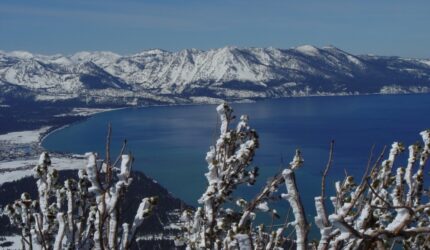 Lake Tahoe was found about a million years ago when the new Sierra Nevada split apart and volcanoes sealed up each end of the gorge that was created. Then glaciers formed and eventually melted into the depression. Water continues to run into the lake from 63 streams and rivers in the 9,000 to 10,000 foot mountains surrounding the lake.
Lake Tahoe was found about a million years ago when the new Sierra Nevada split apart and volcanoes sealed up each end of the gorge that was created. Then glaciers formed and eventually melted into the depression. Water continues to run into the lake from 63 streams and rivers in the 9,000 to 10,000 foot mountains surrounding the lake.
Native Americans visited Lake Tahoe every summer centuries before anyone else knew a huge lake lay in these mountains. On Feb. 14, 1844, John C. Fremont saw it, but it was the Gold Rush of 1849 and a decade later the discovery of Comstock Lode silver that brought people to the lake. As yet, no one stayed the winter, not even the natives. It was the only avenue to Nevada in the 1860’s. Freight was shipped from San Francisco, up the Sacramento Rivers, and then on trails past Placerville and over Echo Summit. Wagons traveled south of the lake on one of the several trails over the eastern Sierra Nevada to the Carson Valley and then to Virgina City.
Sawmills, lumber companies, flumes and railroads were hastily built to take advantage of Tahoe’s bountiful forests. To support railroads and two huge booms of cut logs along the shore and across the lake, the first steamboats appeared in 1864. They were the workhorses of the lumber business at the lake until 1898. The difficulty of reaching the lake eased in 1896 when the Transcontinental Railroad opened. Visitors disembarked on one of the steamers to their destination. By 1952, the population had grown and the few who stayed through the winters were inundated and isolated by the biggest storm in recent memory. Tahoe was big news around the country.
However, it was the Winter Olympic Games at Squaw Valley in 1960 that showed Lake Tahoe at its best. The beauty of the lake, its mountains and wilderness, were featured every day for two weeks in the first winter games to be televised live to the whole country. A real estate boom followed and summer resorts and ski areas opened as the population grew again.
By the 1970’s awareness of the environment and what we were doing to it became widespread. Curbs were put on building and concern was rising over the ecology of the lake. Lake Tahoe became a testing ground for environmental regulation.
Above information provided by Lynn Landauer, Lake Tahoe Historical Society.
